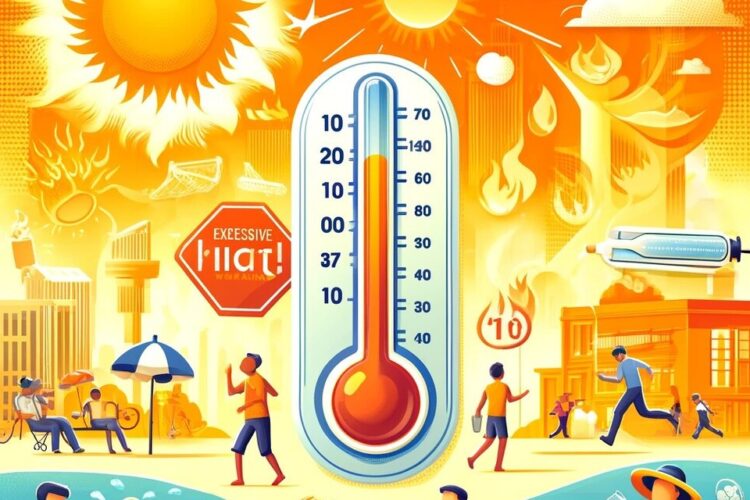When an excessive heat warning is issued, it means that temperatures are expected to soar to dangerously high levels. Such conditions can pose serious health risks, particularly to vulnerable populations such as the elderly, children, and those with preexisting health conditions. However, everyone is susceptible to the dangers of extreme heat. This guide will provide you with practical tips and advice to stay cool and safe during an excessive heat warning.
Understanding Excessive Heat Warnings
An excessive heat warning is typically issued by meteorological agencies when high temperatures are forecasted to significantly impact health and safety. These warnings are crucial as they alert the public to take necessary precautions to prevent heat-related illnesses such as heat exhaustion and heat stroke.
Why Is Extreme Heat Dangerous?
Extreme heat can lead to severe health issues, including:
- Heat Exhaustion: Symptoms include heavy sweating, weakness, dizziness, nausea, and fainting. It occurs when your body loses excessive amounts of water and salt, usually through sweating.
- Heat Stroke: A more severe condition where the body’s temperature regulation fails. Symptoms include a high body temperature (above 103°F), rapid pulse, confusion, and unconsciousness. Heat stroke is a medical emergency and requires immediate attention.
Tips to Beat the Heat
Here are some practical steps you can take to stay cool and safe during an excessive heat warning:
Stay Hydrated
- Drink Plenty of Water: Your body loses a lot of fluids through sweating, so it’s essential to drink water regularly, even if you don’t feel thirsty. Aim for at least 8-10 glasses a day.
- Avoid Alcohol and Caffeine: These substances can dehydrate your body. Stick to water, herbal teas, and natural fruit juices.
- Replenish Electrolytes: If you’re sweating a lot, consider drinking sports drinks that replenish electrolytes. Alternatively, you can eat fruits like bananas and oranges.
Keep Cool
- Stay Indoors: If possible, stay inside during the hottest parts of the day, typically between 10 a.m. and 4 p.m. If your home isn’t air-conditioned, seek out public places like malls, libraries, or community centers that have cooling facilities.
- Use Fans and Air Conditioning: Fans can help circulate air, and air conditioning can significantly reduce indoor temperatures. If you don’t have air conditioning, consider visiting places that do.
- Take Cool Showers or Baths: This can help lower your body temperature. You can also use a wet cloth on your skin or a cool compress on your head and neck.
Dress Appropriately
- Wear Lightweight, Loose-Fitting Clothing: Choose light-colored clothes made of breathable fabrics like cotton.
- Protect Your Head: Wear a wide-brimmed hat to shield yourself from the sun, and consider using an umbrella for added shade.
- Use Sunscreen: Apply a broad-spectrum sunscreen with an SPF of at least 30 to all exposed skin to protect yourself from harmful UV rays.
Modify Your Activities
- Limit Outdoor Activities: Try to schedule strenuous activities like exercise or yard work for the cooler parts of the day, such as early morning or late evening.
- Take Frequent Breaks: If you must be outside, take frequent breaks in the shade or a cool environment.
- Pace Yourself: Reduce the intensity of your activities. Listen to your body and stop if you start feeling dizzy, weak, or nauseous.
Stay Informed
- Monitor Weather Reports: Keep an eye on local weather forecasts for updates on heat warnings and expected temperatures.
- Know the Symptoms of Heat-Related Illnesses: Familiarize yourself with the signs of heat exhaustion and heat stroke so you can act quickly if necessary.
Special Considerations for Vulnerable Populations
Certain groups are more at risk during extreme heat events. Here are some additional tips for these populations:
For the Elderly
- Check on Older Relatives and Neighbors: Ensure they have a cool place to stay and are drinking enough fluids.
- Medications: Some medications can affect the body’s ability to regulate temperature. Check with a healthcare provider if there are any concerns.
For Children
- Never Leave Children in a Parked Car: Even for a few minutes, as temperatures inside a car can rise rapidly and become life-threatening.
- Keep Kids Hydrated: Ensure they drink plenty of water and take regular breaks from playing outside.
For Pets
- Provide Plenty of Water: Make sure pets have access to fresh, cool water at all times.
- Keep Pets Indoors: During extreme heat, keep pets inside where it’s cooler. Avoid walking them during the hottest parts of the day.
Emergency Measures
In case of heat-related emergencies, knowing what to do can save lives. Here’s what to do if you or someone else is experiencing heat exhaustion or heat stroke:
Heat Exhaustion
- Move to a Cooler Place: Find shade or go indoors.
- Hydrate: Drink water or a sports drink.
- Cool Down: Use a cool cloth or take a cool shower.
Heat Stroke
- Call 911 Immediately: Heat stroke is a medical emergency.
- Move to a Cooler Environment: Try to cool the person down with any means available.
- Use Cool Cloths or Ice Packs: Place them on the neck, armpits, and groin.
- Do Not Give Fluids: If the person is unconscious, do not attempt to give them fluids.
Conclusion
An excessive heat warning is a serious alert that requires immediate attention and action to protect yourself and others from the dangers of extreme heat. By staying hydrated, keeping cool, dressing appropriately, modifying your activities, and staying informed, you can beat the heat and stay safe. Always remember to look out for vulnerable populations such as the elderly, children, and pets. With these tips, you’ll be well-prepared to handle any heatwave that comes your way.
Stay cool, stay safe, and take care of yourself and your loved ones during these hot days!




0 Comments